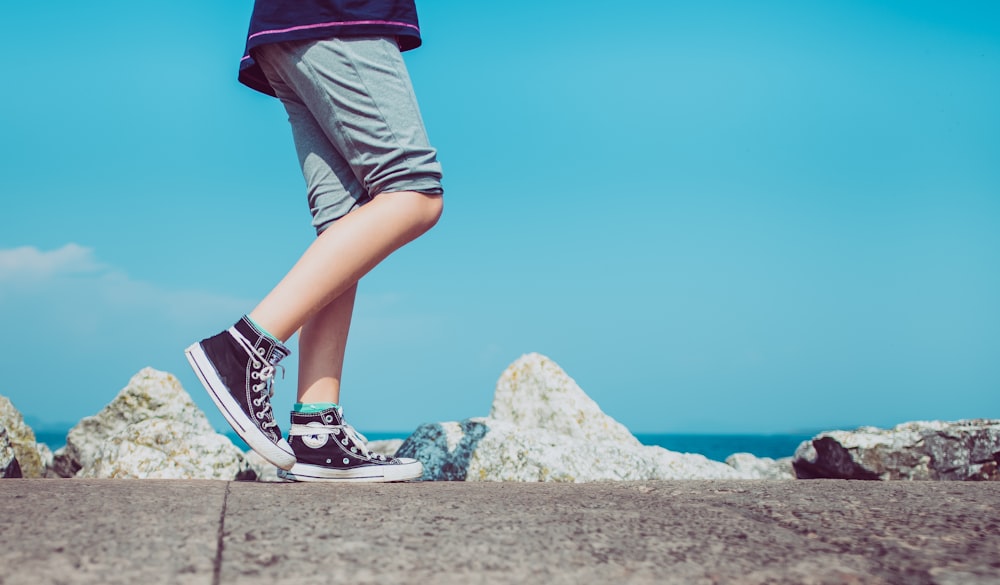目次
脳卒中片麻痺症例の分廻し歩行はClearanceを代償するものではない?
脳卒中片麻痺症例の異常歩行として昔から多いのが分廻し歩行です.
分廻し歩行というのはClearanceを代償するために起こるといった考え方が主流でありましたが,実は分廻し歩行はClearanceを代償するためのものではない可能性があります.
今回は脳卒中片麻痺症例の分廻し歩行はClearanceを代償するものではないといったお話です.

今回ご紹介する論文
J Biomech. 2019 Apr 18;87:150-156. doi: 10.1016/j.jbiomech.2019.02.026. Epub 2019 Mar 8.
Hip circumduction is not a compensation for reduced knee flexion angle during gait
Tunc Akbas 1, Sunil Prajapati 2, David Ziemnicki 2, Poornima Tamma 2, Sarah Gross 2, James Sulzer 2
Affiliations expand
PMID: 30876735 DOI: 10.1016/j.jbiomech.2019.02.026
今回ご紹介する論文は2019年に掲載された論文です.
研究の背景
It has long been held that hip abduction compensates for reduced swing-phase knee flexion angle, especially in those after stroke. However, there are other compensatory motions such as pelvic obliquity (hip hiking) that could also be used to facilitate foot clearance with greater energy efficiency. Our previous work suggested that hip abduction may not be a compensation for reduced knee flexion after stroke. Previous study applied robotic knee flexion assistance in people with post-stroke Stiff-Knee Gait (SKG) during pre-swing, finding increased abduction despite improved knee flexion and toe clearance. Thus, our hypothesis was that hip abduction is not a compensation for reduced knee flexion.
特に脳卒中後症例では遊脚相の膝屈曲角の減少を股関節外転で代償することが多いとされてきました.
しかしながら骨盤挙上(ヒップハイク)など他の代償動作もあり,より高いエネルギー効率で足のクリアランスを促進することができると考えられています.
股関節外転つまり分廻し歩行は脳卒中後の膝屈曲の減少を代償するものではない可能性も考えられます.
脳卒中後のStiff knee gaitにおいて遊脚前にロボットによる膝屈曲補助を行ったところ,膝屈曲と足趾運動が改善されたにもかかわらず,股関節外転が増加することが明らかにされております.
こういった結果からこの研究では分廻し歩行は膝関節屈曲の減少を補うものではないといった仮説を立てております.
研究の方法
We simulated the kinematics of post-stroke SKG on unimpaired individuals with three factors: a knee orthosis to reduce knee flexion, an ankle-foot orthosis commonly worn by those post-stroke, and matching gait speeds. We compared spatiotemporal measures and kinematics between experimental factors within healthy controls and with a previously recorded cohort of people with post-stroke SKG. We focused on frontal plane motions of hip and pelvis as possible compensatory mechanisms.
脳卒中後遺症のない健常者を対象として膝の屈曲を減少させる膝装具,脳卒中後遺症者がよく装着する足首・足部装具,歩行速度の3要素を用いて,脳卒中後のStiff knee gaitの運動学的シミュレーションを実施しております.
この研究では健常対照者と脳卒中後のStiff knee gaitのコホートにおいて,実験因子間の時空間的な測定と運動学的な比較を行っております.
代償機構として股関節と骨盤の前額面運動に着目しております.
研究の結果
We observed that regardless of gait speed, knee flexion restriction increased pelvic obliquity (2.8°, p < 0.01) compared to unrestricted walking (1.5°, p < 0.01), but similar to post-stroke SKG (3.4°). However, those with post-stroke SKG had greater hip abduction (8.2°) compared to unimpaired individuals with restricted knee flexion (4.2°, p < 0.05).
結果として歩行速度に関わらず膝屈曲制限は,制限のない歩行(1.5°、p<0.01)に比べ,骨盤挙上を増加させておりましたが,脳卒中後のStiff knee gait(3.4°)と同程度であることが確認されました.
しかし脳卒中後のStiff knee gaitは膝の屈曲に制限のある非障害者(4.2°、p<0.05)と比較して股関節外転が大きい結果(8.2°)でありました.
研究の結論
These results show that pelvic obliquity, not hip abduction, compensates for reduced knee flexion angle. Thus, other factors, possibly neural, facilitate exaggerated hip abduction observed in post-stroke SKG.
これらの結果は膝屈曲角度の減少を補うのは股関節外転ではなく骨盤の居城であることが示唆されます.
したがって脳卒中後のStiff knee gaitで観察される分廻し歩行は,他の要因(おそらく神経的要因)により助長されることが示唆されました.
|
|
非常に興味深い結果ですね.
脳卒中片麻痺症例では骨盤挙上によってクリアランスを確保しているということですね.
分廻しは他の要因が大きいといったことを考慮する必要がありますね.




![[商品価格に関しましては、リンクが作成された時点と現時点で情報が変更されている場合がございます。] [商品価格に関しましては、リンクが作成された時点と現時点で情報が変更されている場合がございます。]](https://hbb.afl.rakuten.co.jp/hgb/2e88b3bc.9dae47fd.2e88b3bd.b85c9a6e/?me_id=1410084&item_id=10000279&pc=https%3A%2F%2Fthumbnail.image.rakuten.co.jp%2F%400_mall%2Fsty1shop%2Fcabinet%2Fhdy-fukubukuro.jpg%3F_ex%3D240x240&s=240x240&t=picttext)



